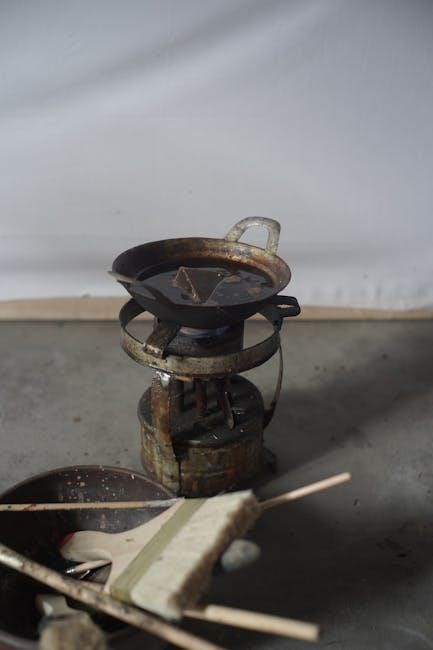beckett afg burner manual
Welcome to the Beckett AFG Burner Manual‚ your comprehensive guide to installing‚ operating‚ and maintaining the Beckett AFG oil burner. This manual ensures safe and efficient operation.
Overview of the Beckett AFG Burner
The Beckett AFG burner is a high-efficiency oil burner designed for residential and commercial heating systems. Known for its reliability and versatility‚ it operates at a fuel range of 0.40 to 3.00 GPH‚ making it suitable for various applications. The burner is engineered to optimize performance while minimizing fuel consumption‚ ensuring cost-effective and environmentally friendly operation. It supports both traditional oil and renewable fuels‚ offering flexibility for different energy needs. The AFG burner features advanced combustion technology‚ ensuring consistent heat output and reduced emissions. Its durable construction and user-friendly design make it a preferred choice among homeowners and professionals. This burner is compatible with a wide range of heating systems‚ including boilers and furnaces‚ and is backed by comprehensive support and training resources from Beckett.
Key Features and Benefits
The Beckett AFG burner offers several key features that enhance its performance and user experience. Its advanced combustion technology ensures efficient fuel utilization‚ reducing energy costs and environmental impact. The burner supports a wide range of fuel options‚ including traditional oil and renewable fuels‚ providing flexibility for different energy needs. With a firing rate range of 0.40 to 3.00 GPH‚ it can be customized to suit various heating requirements. The AFG burner is equipped with a robust design‚ ensuring durability and long-lasting performance. Additionally‚ it features user-friendly controls and compatibility with multiple heating systems‚ making installation and operation straightforward. Safety is prioritized with built-in hazard mitigation features‚ and comprehensive technical support is available for troubleshooting and maintenance. These benefits make the Beckett AFG burner a reliable and efficient choice for heating applications.

Installation Guidelines
Adhering to the Beckett AFG Burner Manual ensures a safe and efficient installation. Prepare the site‚ connect fuel lines‚ and ensure proper ventilation. Follow local regulations and manufacturer recommendations for optimal setup.
Pre-Installation Requirements
Before installing the Beckett AFG burner‚ ensure the site meets all safety and technical specifications. Verify the area is well-ventilated and free from flammable materials. Check local building codes and regulations for compliance. Ensure the burner’s voltage and frequency match the power supply. Properly prepare the fuel supply line‚ ensuring it is clean and free from debris. Verify the compatibility of the burner with the heating system. Review the manual thoroughly and gather all necessary tools and components. Ensure the installation area is clear and accessible to avoid any obstacles during the process. Proper preparation ensures a smooth and safe installation experience.
Step-by-Step Installation Process
Begin by connecting the fuel line to the burner‚ ensuring it is clean and free from debris. Mount the burner securely to the heating system‚ following the manufacturer’s alignment specifications. Connect the electrical supply‚ verifying the voltage and frequency match the burner’s requirements. Install the air tube‚ ensuring it is properly seated and aligned for optimal combustion. Connect the ignition system and fuel pump‚ referring to the manual for specific wiring diagrams. Once all connections are secure‚ perform a leak test on the fuel line. Finally‚ prime the fuel system and test the burner’s operation‚ adjusting settings as needed for proper ignition and flame quality. Always refer to the manual for detailed diagrams and specific instructions.
Post-Installation Checks and Safety Measures
After installation‚ perform a thorough inspection to ensure all connections are secure and properly sealed. Conduct a fuel line leak test using a soapy water solution to detect any potential leaks. Check the electrical connections for tightness and verify the correct voltage supply. Ensure proper ventilation and airflow around the burner to prevent carbon monoxide buildup. Test the burner’s ignition system and monitor for consistent flame quality. Inspect the air tube and combustion chamber for blockages or debris. Verify that all safety shut-offs and emergency stop functions are operational. Finally‚ document the installation and perform a final safety review to ensure compliance with local codes and regulations. Always refer to the manual for specific post-installation procedures and safety guidelines.
Operating the Beckett AFG Burner
The Beckett AFG Burner is designed for efficient and reliable operation. Follow manual guidelines for startup‚ configuration‚ and monitoring to ensure optimal performance and safety standards.
Startup and Initial Configuration

Starting the Beckett AFG Burner requires careful preparation to ensure safe and efficient operation. Begin by verifying all pre-installation requirements are met‚ including proper fuel line connections and ventilation. Ensure the burner is correctly aligned with the combustion chamber and that all electrical connections are secure. Refer to the manual for specific startup procedures‚ as improper initialization can lead to safety hazards or reduced performance. Once powered on‚ follow the step-by-step configuration guide to set the burner’s firing rate and combustion parameters. Conduct a test run to monitor flame quality and adjust settings as needed. Always adhere to the manufacturer’s instructions and safety precautions during the startup process. Proper initial configuration is crucial for optimal burner performance and longevity.
Adjusting Burner Settings for Optimal Performance
Adjusting the Beckett AFG Burner settings is crucial for achieving optimal performance and efficiency. Start by consulting the manual to understand the recommended firing rate range‚ typically measured in gallons per hour (GPH). Use the control panel or knobs to modify airflow and fuel pressure‚ ensuring these settings align with your specific application. Monitor the burner’s performance by checking for a clean burn‚ proper flame color‚ and minimal emissions. Avoid over-adjusting‚ as this can lead to inefficiency or safety hazards. After making changes‚ run the burner for a test period to assess stability and efficiency. Document your adjustments for future reference and consider professional assistance if complex changes are required. Always adhere to safety guidelines to prevent potential risks like fire or asphyxiation.
Daily Operation and Monitoring Best Practices
Daily operation and monitoring of the Beckett AFG Burner require consistent checks to ensure efficiency and safety. Start by verifying fuel levels and ensuring the burner is properly lubricated. Monitor combustion performance by checking for a clean‚ stable flame and adjusting settings as needed. Regularly inspect fuel lines‚ nozzles‚ and air tubes for blockages or damage. Measure emissions and combustion efficiency using appropriate tools to ensure optimal performance. Keep a log of operational data‚ including fuel usage and burner settings‚ for future reference. Perform visual inspections of all components to identify potential issues early. Always follow the manufacturer’s guidelines for daily checks and maintenance to prevent hazards and prolong the burner’s lifespan.

Maintenance and Troubleshooting
Regular maintenance ensures optimal performance and safety. Clean the burner‚ inspect fuel lines‚ and replace worn parts. Troubleshoot issues promptly to prevent major repairs.
Regular Maintenance Tasks
Regular maintenance is crucial for the Beckett AFG burner’s efficiency and safety. Clean the burner nozzle and combustion chamber monthly to ensure proper fuel flow and combustion. Inspect fuel lines for leaks or damage and replace worn components. Check the air tube and venting system for blockages or corrosion. Verify the fuel pump pressure and adjust as needed. Replace the oil filter annually and inspect the heat exchanger for signs of wear. Schedule annual professional servicing to ensure optimal performance and safety. Always refer to the manual for specific instructions and safety precautions.
Troubleshooting Common Issues
Troubleshooting your Beckett AFG burner involves identifying and addressing common issues promptly. If the burner fails to start‚ check the fuel supply‚ power connections‚ and ignition system. A weak or unstable flame may indicate improper air/fuel mixture or a clogged nozzle. Adjust the burner settings or clean the nozzle as needed. If the burner shuts off unexpectedly‚ inspect for overheating or faulty safety sensors. Low fuel pressure or a malfunctioning pump can also cause performance issues. Refer to the manual for diagnostic charts and step-by-step solutions. Always ensure proper ventilation and adhere to safety guidelines when troubleshooting; If issues persist‚ consult a qualified technician to avoid hazards and ensure optimal burner performance.
Scheduled Service Intervals
Regular maintenance is crucial for the longevity and efficiency of your Beckett AFG burner. Schedule annual professional inspections before each heating season to ensure optimal performance; Replace the nozzle and clean or replace the air filter every 500 hours of operation. Inspect the combustion chamber and heat exchanger annually for signs of wear or damage. Lubricate moving parts and check the fuel line for leaks or blockages. Every three years‚ replace the oil pump and perform a thorough system cleaning. Adhere to the manufacturer’s recommendations for replacement parts and maintenance procedures. Keeping a maintenance log will help track service intervals and ensure compliance with safety standards. Consistent upkeep prevents unexpected breakdowns and maintains peak efficiency.

Safety Precautions and Warnings
Always follow safety guidelines to avoid risks. Improper installation or adjustment can cause fire‚ smoke‚ or asphyxiation hazards. Keep flammable materials away from the burner.
Potential Hazards and Risk Mitigation
The Beckett AFG burner poses risks such as fire‚ smoke‚ and asphyxiation if not installed or maintained properly. To mitigate these risks‚ ensure proper ventilation in the area where the burner is installed. Keep flammable liquids and vapors away from the burner to prevent accidental ignition. Regularly inspect fuel lines and connections for leaks‚ and address any issues promptly. Additionally‚ ensure that only qualified personnel perform adjustments or repairs‚ adhering strictly to the manufacturer’s guidelines. Always follow the safety precautions outlined in the manual to minimize hazards and ensure safe operation. Proper maintenance and adherence to safety protocols are crucial to preventing potential dangers associated with the burner.